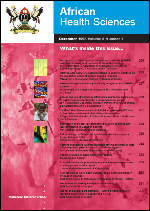
|
African Health Sciences
Makerere University Medical School
ISSN: 1680-6905
EISSN: 1680-6905
Vol. 18, No. 1, 2018, pp. 79-89
|
 Bioline Code: hs18012
Bioline Code: hs18012
Full paper language: English
Document type: Study
Document available free of charge
|
|
|
African Health Sciences, Vol. 18, No. 1, 2018, pp. 79-89
| en |
Human bite as a weapon of assault
Robsam, Samuel Ohayi; Ihechi, Emeka Udeh & Olufemi, William Odesanmi
Abstract
Background: Human bite is a growing public health concern. It may be seen in both victims and aggressors following assault.
Effects of human bite are both social and medical.
Objectives: This study aims to determine the prevalence and characteristics of assault-related human bite injuries in Enugu,
Nigeria.
Methods: In this prospective study, an objective structured questionnaire was administered to assault victims attending the Forensic
unit of ESUT Teaching Hospital between November 2013 and October 2014. Obtained data was analyzed.
Results: Out of 219 patients presenting with clinical injuries, 29 (13.2%) sustained human bite wounds. Average age was
32.2±11.30 years and 34.3±12.4 years for victims and biters respectively. Females were more involved than males. Severe injuries
resulted more in bites involving females than males. Contusion (47.6%) and laceration (31.0%) were the commonest. Upper
limbs were mostly affected (44.7%) followed by the face (29.0%). Romance-related injuries affected breasts and thighs. Most
incidents (62.1%) occurred within home/living quarters. Most biters were known to their victims.
Conclusion: Human bite is a common outcome of assault and so should be anticipated in cases of assault. Patterns of location
of bites seem related to nature of crime.
Keywords
Human bite; teeth; weapon; assault; victim; biter.
|
| |
© Copyright 2018 - African Health Sciences
|
|
